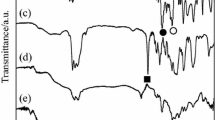Abstract
An electrochemical microreactor for organic electrosynthesis has been investigated for the anodic synthesis of 4-methylanisole to 4-methoxy-benzaldehyde-dimethylacetal in methanol solution. Selectivity and conversion in the single-pass thin-gap flow reactor were examined as a function of the composition of the electrolyte solution, the flow rate and the applied current. The experimental results indicate that potassium fluoride currently used for industrial synthesis and providing higher yields than sodium perchlorate, exerts an influence on the reaction mechanism: high KF concentrations facilitate the undesired oxidation of the diacetal. Nevertheless, a feed solution containing 0.1 M anisole in 0.01 M KF can be converted at 90% in the 100 μm thin-gap cell with acceptable voltages and a measured selectivity of nearly 87%. The selectivity observed substantially higher than that typically observed in conventional electrochemical cells.









Similar content being viewed by others
References
Bersier BM, Carlsson L, Bersier J (1994) Topics in current chemistry. Springer-Verlag, Berlin, Heidelberg
Lund H, Hammerich O (2001) Organic electrochemistry, 4th edn. Marcel Dekker, New York
Pletcher D, Walsh FC (1990) Industrial electrochemistry, 2nd edn. Chapman-Hall, London–New York, 1990
Nishiguchi I, Hirashima T (1985) J Org Chem 50:539
Degner D (1988) Organic electrochemistry in industry. In: Topics in current chemistry. Springer-Verlag, Berlin, Heidelberg
Löwe H, Ehrfeld W (1999) Electrochim Acta 44:3679
Rode S, Altmeyer S, Matlosz M (2004) J Appl Electrochem 34:671
Wendt H, Bitterlich S (1992) Electrochim Acta 37:1951
Wendt H, Bitterlich S, Lodowicks E, Liu Z (1992) Electrochim Acta 37:1959
Lindermeir A, Horst C, Hoffmann U (2003) Ultrasonics Sonochem 10:223
Bitterlich S (1990) PhD thesis, TH Darmstadt
Venkatachalapathy MS, Ramaswamy R, Udupa HVK (1958) Bull Acad Polon Sci Ser Sci Chim 6:478
Wendt H, Schneider H (1986) J Appl Electrochem 16:134
Attour A, Rode S, Bystron T, Matlosz M, Lapicque F (2007) J Appl Electrochem 37:861
Beck F (1987) Organic electrosynthesis, Ullmann’s encyclopedia of industrial chemistry. VCH Verlagsgesellschaft mbH, Weinheim
Küpper M, Hessel V, Löwe H, Stark W, Jinkel J, Michel M, Schmidt-Traub H (2003) Electrochim Acta 48:2889
Ziogas A, Löwe H, Küpper M, Ehrfeld W (2000) Electrochemical microreactors: a new approach for microreaction technology. In: Ehrfeld W (ed) Microreaction technology: industrial prospects, IMRET3: Proceedings of the 3rd international conference on microreaction technology, Frankfurt/Main. Springer-Verlag, Berlin, pp 136–156
Cao E, Gavridilis A, Motherwell WB (2004) Chem Eng Sci 59:4803
Ge H, Chen G, Yuan Q, Li H (2005) Catalysis Today 110:171
Paddon CA, Pritchard GJ, Thiemann T, Marken F (2002) Electrochem Commun 4:825
Horri D, Atobe M, Fuchigami T, Marken F (2005) Electrochem Commun 7:35
He P, Watts P, Maken F, Haswell SJ (2005) Electrochem Commun 7:918
Goodridge F, Scott K (1995) Electrochemical process engineering. Plenum Press, New York and London
Pickett DJ (1979) Electrochemical reactor design, 2nd edn. Elsevier, New York, 1979
Attour A (2007) Réacteur d’électrosynthèse microstructuré: conception, étude et développement appliqués à l’oxydation du 4-méthylanisole, PhD Dissertation, INPL, Nancy (in French)
Acknowledgments
Financial support for this work was provided by the European Project Impulse (project reference ID NMP2-CT-2005-011816 of the 6th Framework Programme for Research and Technological Development of the European Union). The authors also thank the French Ministry of Research for the PhD grant allocated to A. Attour.
Author information
Authors and Affiliations
Corresponding author
Rights and permissions
About this article
Cite this article
Attour, A., Rode, S., Ziogas, A. et al. A thin-gap cell for selective oxidation of 4-methylanisole to 4-methoxy-benzaldehyde-dimethylacetal. J Appl Electrochem 38, 339–347 (2008). https://doi.org/10.1007/s10800-007-9444-8
Received:
Revised:
Accepted:
Published:
Issue Date:
DOI: https://doi.org/10.1007/s10800-007-9444-8




